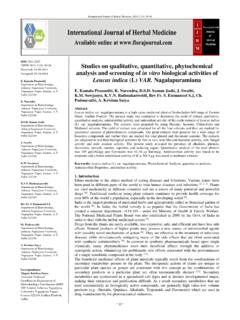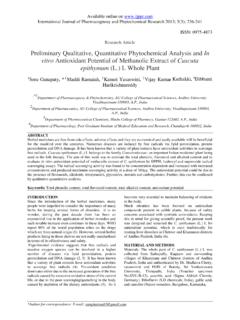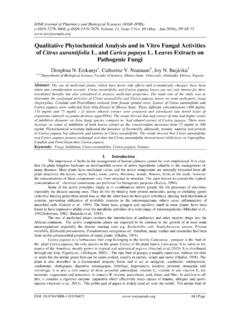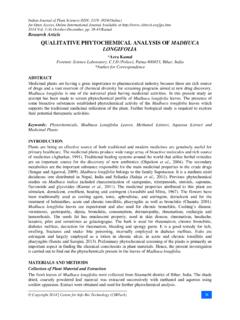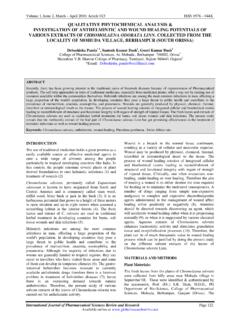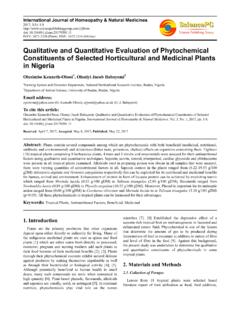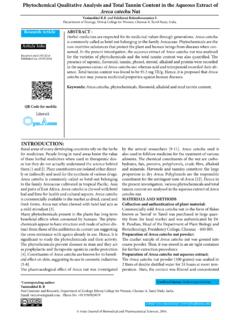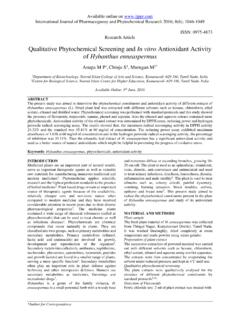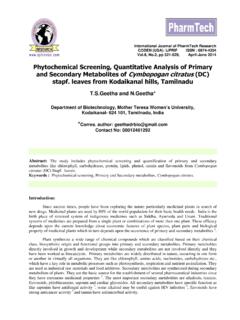Transcription of Fundamentals of Quantitative Research - Chula
1 Fundamentals of Quantitative Research Suphat Sukamolson, Language Institute Chulalongkorn University Abstract The main purpose of this article is to introduce some important fundamental concepts of Quantitative Research to readers especially novice researchers. It comprises types of Research , definitions of Quantitative Research , different types and assumptions of Quantitative Research , when to use and not to use Quantitative methods, advantages, common approaches and samples of Quantitative Research , and common misconceptions. Besides, a set of criteria for evaluating Quantitative Research proposal is provided. The main focus is on the assumptions underlying the Quantitative Research and some of the misconceptions that many researchers have when they are conducting a Research study.
2 Types of Research It is not easy to say how many types of Research there are because different researchers or educators may use different criteria to classify Research types. Generally speaking, Research can be classified into 3 main groups based on the application of the Research study, its objectives in undertaking the Research and how the information is sought. Each group can be subdivided into different types as follows: (Kumar, 1996) Types of Research Figure 1. Types of Research Pure Research Applied Research Applications Descriptive Research Exploratory Research Objectives Types of information sought Qualitative Research Quantitative Research Correlational Research Explanatory Research Research can also be classified according to the time when the data are collected for investigation Therefore, it can be divided into 3 main groups: historical Research , present Research and futuristic Research .
3 Each group can be subdivided into many types. This paper will mainly focuses on Quantitative Research . What is Quantitative Research ? Different researchers and educators give different definitions to Quantitative Research . Here are some of them: Quantitative Research is the numerical representation and manipulation of observations for the purpose of describing and explaining the phenomena that those observations reflect. It is used in a wide variety of natural and social sciences, including physics, biology, psychology, sociology and geology(Wikipedia Encyclopedia, 2005). In addition, according to Cohen (1980), Quantitative Research is defined as social Research that employs empirical methods and empirical He states that an empirical statement is defined as a descriptive statement about what is the case in the real world rather than what ought to be the case.
4 Typically, empirical statements are expressed in numerical terms, Another factor in Quantitative Research is that empirical evaluations are applied. Empirical evaluations are defined as a form that seeks to determine the degree to which a specific program or policy empirically fulfills or does not fulfill a particular standard or norm. Moreover, Creswell (1994) has given a very concise definition of Quantitative Research as a type of Research that is `explaining phenomena by collecting numerical data that are analyzed using mathematically based methods (in particular statistics).' Let's study this definition step by step. The first element is explaining phenomena. This is a key element of all Research , be it Quantitative or qualitative. When we set out to do some Research , we are always looking to explain something.
5 In education this could be questions, for example, `Does constructivism work for teaching English in a Thai context?', or `What factors influence student achievement in learning English as a foreign language?' The specificity of Quantitative Research lies in the next part of the definition. In Quantitative Research we collect numerical data. This is closely connected to the final part of the definition: analysis using mathematically-based methods. In order to be able to use mathematically based methods our data have to be in numerical form. This is not the case for qualitative Research . Qualitative data are not necessarily or usually numerical, and therefore cannot be analyzed using statistics. The last part of the definition refers to the use of mathematically based methods, in particular statistics, to analyze the data.
6 This is what people usually think about when they think of Quantitative Research , and is often seen as the most important part of Quantitative studies. This is a bit of a misconception. While it is important to use the right data analysis tools, it is even more important to use the right Research design and data collection instruments. However, the use of statistics to analyze the data is the element that puts a lot of people off doing Quantitative Research , because the mathematics underlying the methods seem complicated and frightening. Therefore, because Quantitative Research is essentially about collecting numerical data to explain a particular phenomenon, particular questions seem immediately suited to being answered using Quantitative methods. For example, How many students learning Experiential English I get A s in the first semester?
7 What percentage of the students learning Experiential English I has negative attitudes towards the course? On average, is there any significant difference between the general English proficiency of the students learning Foundation English and Experiential English courses? These are all questions we can look at quantitatively, as the data we need to collect are already available to us in numerical form. However, there are many phenomena we might want to look at, but which don't seem to produce any Quantitative data. In fact, relatively few phenomena in education actually occur in the form of `naturally' Quantitative data. Luckily, we are far less limited than what might appear above. Many data that do not naturally appear in Quantitative form can be col-lected in a Quantitative way.
8 We do this by designing Research instruments aimed specifically at converting phenomena that don't naturally exist in Quantitative form into Quantitative data, which we can analyze statistically. Examples of this are attitudes and beliefs. We might want to collect data on students' attitudes to their school and their teachers. These attitudes obviously do not naturally exist in Quantitative form. However, we can develop a questionnaire that asks pupils to rate a number of statements (for example, `I think school is boring') as either agree strongly, agree, disagree or disagree strongly, and give the answers a number ( 1 for disagree strongly, 4 for agree strongly). Now we have Quantitative data on pupil attitudes to school. In the same way, we can collect data on a wide number of phenomena, and make them Quantitative through data collection instruments like questionnaires or tests.
9 We will later look at how we can develop instruments for this particular purpose. The number of phenomena we can study in this way is almost unlimited, making Quantitative Research quite flexible. However, not all phenomena are best studied using Quantitative methods. While Quantitative methods have some notable advantages, they also have disadvantages. This means that some phenomena are better studied using qualitative methods. In short, Quantitative Research generally focuses on measuring social reality. Quantitative Research and/or questions are searching for quantities in something and to establish Research numerically. Quantitative researchers view the world as reality that can be objectively determined so rigid guides in the process of data collection and analysis are very important.
10 Different Types of Quantitative Research There are several types of Quantitative Research . For instance, it can be classified as 1) survey Research , 2) correlational Research , 3) experimental Research and 4) causal-comparative Research . Each type has its own typical characteristics. Let s take survey Research as an example: Survey Research uses scientific sampling and questionnaire design to measure characteristics of the population with statistical precision. It seeks to provide answers to such questions as "How many people feel a certain way?" and "How often do they do a certain behavior?" Survey Research enables management to make comparisons between groups. It provides estimates from a sample that can be related to the entire population with a degree of certainty ( , 57% of the population +/- 3% will answer the question this way 95% of the time).
